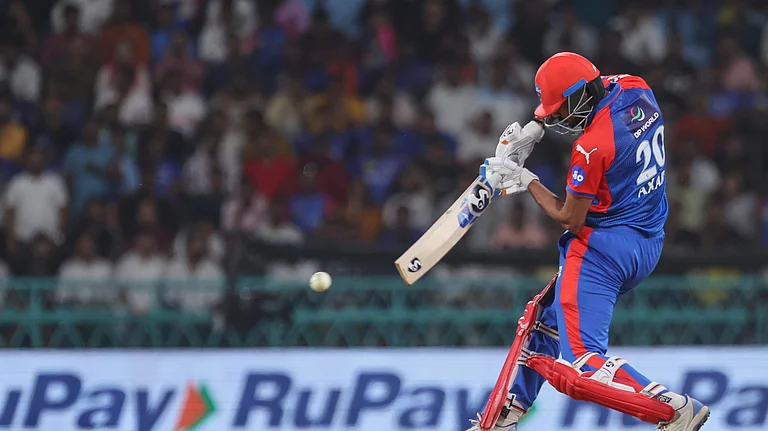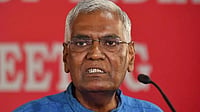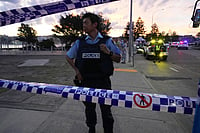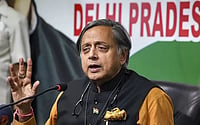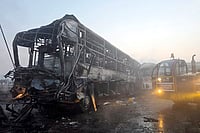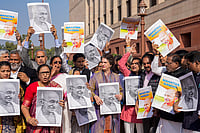MOTIVATION, in a place one kilometre from the nearest spot of natural light, 80 m below the surface of the earth where humidity levels ensure a constant sauna, is certainly not the easiest available commodity. But the 20-odd sweating souls defy nature and continue to chip on as if programmed from birth to chisel. Their task: to overwhelm Mother Earth by making way for trains to pass through some of the most difficult terrain in the subcontinent and realise the dream of a Konkan railway line.
The 760-km west coast railway line connecting Roha in Maharashtra with Mangalore in Karnataka, the missing link in the world's largest railway network, is liter-ally stuck in soft soil as work on three major tunnels in the Goa sector and one in Karnataka progress at snail's pace. At present, 90 per cent of the megaproject awaits the completion of the remaining 10 per cent which is mired in slush, soft soil and hard rock, resulting in a further rescheduling of the commissioning of the line, much like the rescheduling of the country's trains.
"Our corporate mission," states a modest board hung in the zonal headquarters of the Konkan Railway Corporation Ltd (KRCL), Panaji, is "to complete the project by 30 June 1996". Proclaims another board in the chief engineer's chamber: "72 days left". But deadlines have long lost their sanctity. The ambitious Rs 2,084 crore project, which has been rescheduled five times thereby forcing a 20-month delay in its commissioning, is racing against time, battling nature's wrath and geographical hurdles. And though the latest deadline for goods traffic movement on the entire stretch is fixed for October this year and December 31 for passenger traffic, KRCL's top brass is cautious about the progress of the project. Past experience involving environmental groups in Goa, a financial crunch and tiffs with mandarins in Rail Bhavan has obviously left them wiser. Says E. Sreedharan, CMD, KRCL: "We are not magicians to work miracles and complete the project in the short time-span, given the kind of problems we have run into. But what we have achieved to date is nothing short of a miracle and I can challenge that it could not have been done faster in similar circumstances."
At the root of the present delay is the long stretches of unstable lithomargic and alumina clay with high seepage levels which collapses as labourers dig through hillocks to build tunnels. At Kurtolim near the southern bank of the Zuari river in Goa, a 300 m long embankment built on slushy marine clay is posing a question mark over even the rescheduled completion of the project. The earth's surface is unable to take the weight of the embankment, causing it to sink. "The fate of the Konkan railway depends on the completion of the tunnels in Goa and the embankment," says P. Sriram, chief engineer, KRCL (Goa Zone).
With a total 92 tunnels envisaged on the entire stretch of the railway, of which nine exceed two km in length, the job was never expected to be easy. And though tunnelling work started at the time of the launch of the project in early 1991, nine tunnels ranging from 500 m to nearly 2 km in length stalled the completion of the pro-ject. Last week, KRCL made a major breakthrough in the 1.96 km Byndoor tunnel, the first on which work was launched and the last to be completed in the Karnataka zone. While that clears the entire stretch in Karnataka with only concrete-lining and track-laying inside the tunnels remaining, the Goa zone has not been as lucky. Work was stalled in Goa for eight months on a 55 km stretch in 1993 after environmental groups raised objections to the railway passing through certain parts of Old Goa and posing a threat to some monuments there. Says Sriram: "While work in Maharashtra and Karnataka progressed smoothly during the eight months, work on either side of the 55 km stretch in Goa was affected."
Tunnelling on the Konkan railway route is done by conventional method where hillocks are pierced through and soil excavated till two ends meet. Steel arches and girders are placed simultaneously below the roof and along the walls and lined with concrete to complete the process. While normal earth makes the task relatively easy, engineers and labourers shed sweat and blood when they run into soft soil or hard rock, especially when the tunnels stretch into kilometres, as in the case of the Konkan railway. Says R. Richardson Asir, chief engineer, KRCL (Udupi and Karwar zones): "To get ahead with tunnelling, we need the earth to be stable. But here we have fine earth mixed with water, leading to collapses and causing hazardous cavities." While the collapse not only impedes progress in tunnelling, it alvated till two ends meet. Steel arches and girders are placed simultaneously below the roof and along the walls and lined with concrete to complete the process. While normal earth makes the task relatively easy, engineers and labourers shed sweat and blood when they run into soft soil or hard rock, especially when the tunnels stretch into kilometres, as in the case of the Konkan railway. Says R. Richardson Asir, chief engineer, KRCL (Udupi and Karwar zones): "To get ahead with tunnelling, we need the earth to be stable. But here we have fine earth mixed with water, leading to collapses and causing hazardous cavities."
While the collapse not only impedes progress in tunnelling, it also endangers the lives of the labour force hard-pressed for motivation. Two labourers have been killed after being trapped under collapsedso endangers the lives of the labour force hard-pressed for motivation. Two labourers have been killed after being trapped under collapsed earth since March this year, one at the Pernem tunnel, North Goa, and the other at the Padi tunnel in South Goa last week. In the first instance, work was stalled for 20 days. This was disastrous for the already delayed project where work goes on 24 hours a day, seven days a week. To overcome the soft soil collapse problem, KRCL decided to proceed with tunnelling in two separate phases—heading, which involves the top arch; and benching, which involves the walls of the tunnels. Arch-shaped steel girders are placed under the roof at a distance of 0.5 m and the space between the arch and the roof is filled with concrete to support the soft soil. More steel girders are placed along the wall of the tunnel and concrete is again filled between the soil-wall and the girders.
That, though, is not the end of the problem. The ribs (steel girders) have to be tested on alternate days, for any movement as the soil exerts pressure from above and the sides, says R. Nagadath, assistant engineer at the Byndoor tunnel, where a 10 m stretch of wall moved 20 cm inwards due to pressure from the sides. Nagadath explains that the movement is due to hydrostatic pressure caused by a perennial water source above and needs to be tackled. According to him, if no movement occurs in the first month after concrete-lining, there won't be any movement later as the concrete sets in, staving off the pressure.
Progress in tunnelling is painfully slow at a metre a day in the soft-soil section and two metres a day in the hard rock section despite there being over two dozen workers at the job round-the-clock. KRCL, as a result, required nearly five years to construct the 1.96 km Byndoor Tunnel. In Goa, on the other hand, 542 m of the 1.5 km Pernem tunnel, 140 m of the 542 m Old Goa tunnel and 90 m of the 1.92 km Padi tunnel, are yet to be excavated. Not surprisingly, the contractors to whom the gru-elling task was awarded withdrew from one tunnel in Karnataka and from two in Goa, forcing KRCL to take up the projects inhouse.
Elsewhere in Kurtolim, rigs are working overtime to drain out the water from the colloidal marine clay on the southern bank of the Zuari river to enable the earth to support the 300 m long, eight m high embankment leading to the bridge over the Zuari. The process involves digging holes in the earth's surface and loading it with sand to force water out and harden the soil. "Loading the earth needs to be done in phases over a period of five or six years as the earth needs to stabilise. Since we don't have that kind of time, we did the loading in a year and the soil is not stabilising," reveals Sreedharan.
As a last resort, KRCL has constructed a bridge for 50 of the 300 m and serious thought is being given to constructing a bridge for the entire stretch to overcome the problem. "But that would mean a further one-year delay," adds Sriram.
Compounding KRCL's woes was the lack of engineering experience in the country in soft-soil tunnelling and, more importantly, a resource crunch that resulted in delays over acquiring latest technologies. While the former is being tackled by consulting experts from abroad and by drawing on the experience of the National Hydroelectric Power Corporation (NHPC) in tunnelling, there was little KRCL could do about the gap in funding. Originally estimated to cost Rs 1,049 crore, the project today has a total cost component of Rs 2,084 crore and the financing is a combination of equity, debt, and lease financing. KRCL planned to raise Rs 750 crore from the market through tax-free bonds at 10.5 per cent interest. Of this, Rs 445 crore was fixed as the target for 1995 though ultimately KRCL succeeded in raising Rs 165 crore. With tunnelling costing Rs 60,000 per metre of soft soil and Rs 25,000 per metre of hard rock terrain, the resource crunch could not have come at a worse time.
"We were not able to divert the necessary funds for the tunnels as we could not raise the kind of money we hoped to from the market," observes Sreedharan. "For the last couple of years, there has been little money in the market. Even institutions like ICICI have defaulted as they faced a resource crunch. And whatever little was floating around was mopped up by the Government which paid 14 per cent interest." Sreedharan reveals that foreign experts consulted by KRCL suggested a mechanical solution to the soft soil problem which the corporation could not adopt as it was expensive. Consequently, they had to continue with manual lab-our. However, since December, KRCL raised Rs 125 crore through sale and lease-back (SLB) facility and a further Rs 350 crore through bonds, taking the total fund mobilisation from the financial market to a delayed but comfortable Rs 1,412 crore.
Last month, Sreedharan visited Germany to acquire a Rs 40-lakh state-of-the-art road-header that will dig and excavate the soft soil simultaneously. The machine is expected to arrive in India by June end, and is hoped to speed up tunnelling.
However, with a question mark still hanging over the completion of the Kurtolim embankment, there are doubts whether the latest deadline is the last. The sweat-bathed labourer in the earth's womb in Pernem and Old Goa will in all probability see the light of day in a few months' time, but the same cannot be said of a locomotive hurtling across Kurtolim.







